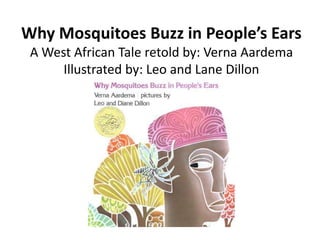
Children's Literature Collaborative Presentation
- 1. Why Mosquitoes Buzz in People’s EarsA West African Tale retold by: Verna AardemaIllustrated by: Leo and Lane Dillon
- 2. Genre: Fantasy, African Folk literature, Myth Plot: Episodic Point of view: Objective / Dramatic Style: Hyperbole, Symbolic, Onomatopoeia Tone: Serious
- 3. Theme: Cause and effect Characters: Mosquito, Iguana, Python, Rabbit, Monkey, Crow, Mother Owl, King Lion. Animal personification, Flat Setting: African Jungle, Backdrop
- 4. The mosquito bothersanimals in the jungle. The mosquito’s bothersome actions ultimately cause the sun not to rise.
- 6. The sun not rising was caused by a sequence of events by the animals, and this event then resulted in a backwards sequence of events.
- 7. The wise Owl brings the animals together to investigate who is to blame.
- 9. The sequence of events results in the natural phenomena of the mosquito forever buzzing in people's ears asking them if they are still angry with him.
- 11. Wrote predominantly retellings of African folktales
- 12. Won the Caldecott Medal in 1975 for “Why Mosquitoes Buzz in People’s Ears”
- 14. They’ve illustrated numerous books, for both children and adults
- 17. Teaching Ideas Study of Africa (geography, culture, climate, history) Science (Animals of Africa) Ethics (Do you take responsibility for your actions?) English Lesson in Onomatopoeia Write and illustrate your own folktale Class Play!
